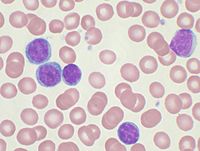
Photo from wikipedia
In this study, a series of 20 chalcone derivatives was synthesized, and their antiproliferative activity was tested against the human T cell acute lymphoblastic leukemia‐derived cell line, CCRF‐CEM. On the… Click to show full abstract
In this study, a series of 20 chalcone derivatives was synthesized, and their antiproliferative activity was tested against the human T cell acute lymphoblastic leukemia‐derived cell line, CCRF‐CEM. On the basis of the structural features of the most active compounds, a new library of chalcone derivatives, according to the structure–activity relationship design, was synthesized, and their antiproliferative activity was tested against the same cancer cell line. Furthermore, four of these derivatives (compounds 3, 4, 8, 28), based on lower IC50 values (between 6.1 and 8.9 μM), were selected for further investigation regarding the modulation of the protein expression of RACK1 (receptor for activated C kinase), protein kinase C (PKC)α and PKCβ, and their action on the cell cycle level. The cell cycle analysis indicated a block in the G0/G1 phase for all four compounds, with a statistically significant decrease in the percentage of cells in the S phase, with no indication of apoptosis (sub‐G0/G1 phase). Compounds 4 and 8 showed a statistically significant reduction in the expression of PKCα and an increase in PKCβ, which together with the demonstration of an antiproliferative role of PKCβ, as assessed by treating cells with a selective PKCβ activator, indicated that the observed antiproliferative effect is likely to be mediated through PKCβ induction.
Journal Title: Archiv der Pharmazie
Year Published: 2020
Link to full text (if available)
Share on Social Media: Sign Up to like & get
recommendations!